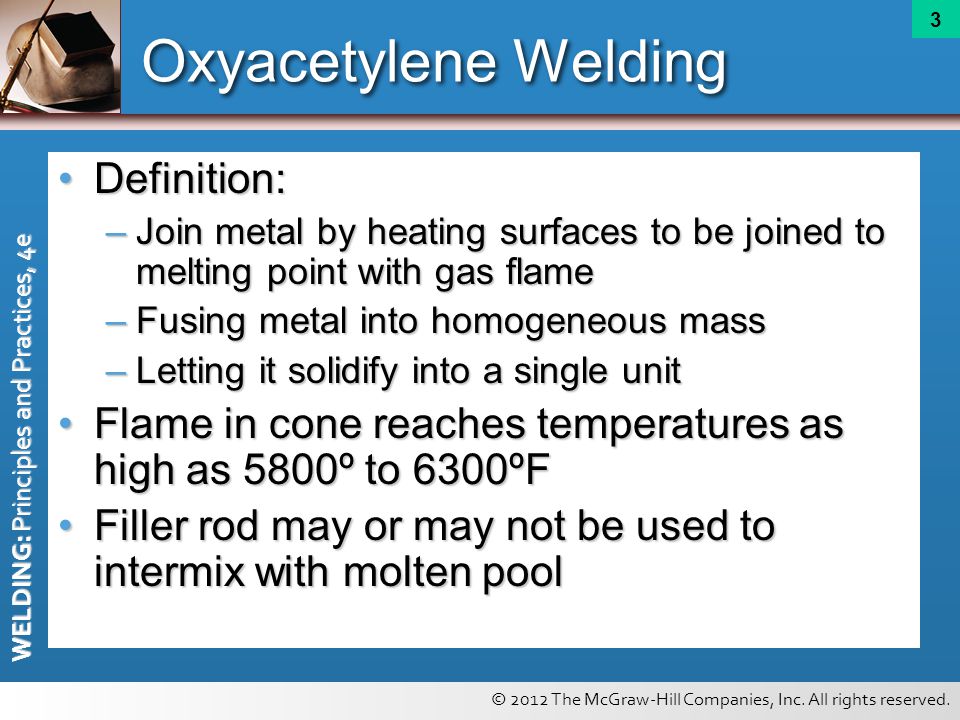The shielding gases used in MIG and TIG welding create a better environment for the 2 metals to join. The gases prevent oxygen and water from getting into the work area that is being welded.
Gas Shielded Arc Welding Processes Tig Mig Mag Openlearn Open University
Shielding gases are inert or semi-inert gases that protect the weld from these harmful gases in the atmosphere.

Welding gases meaning. Some gases are great in numerous applications like pure argon for most TIG welding projects and a mix of argon and C02 for most MIG welding jobs. This process is particularly suitable for joining metal. Gases Used for Gas Metal Arc Welding Welding Gas is the main component in MIG Metal Inert Gas welding as these inert gases wont react with the welding bead where non-inert gases like oxygen can react with outside air and cause the bead to become highly porosity.
Gas welding is a type of liquid state welding process in which fuel gases burns to generate heat. Reducing shielding gases in welding technology are always mixed gases consisting of argon or nitrogen with hydrogen. Gases are an essential part of every welders job.
Shielding Gases for Different Metals in GTAW Welding There are many gases used in welding processes and other related welding cutting processes. Knowing the different gases and their purposes will help ensure your welds will be the highest quality possible for their use. This process can be done with or without help of filler material.
Common and natural gases used for welding include Argon Carbon dioxide Oxygen and Helium. Argon with hydrogen is used for example in TIG welding of stainless steel. Combined with an outer filler material for legitimate welding.
This heat is further used to melt interface surfaces of welding plates which are held together to form a joint. MIG metal inert gas welding is a semi-automatic welding type. Gas-welding process involves the utilization of a centered and outrageous high-temperature burst which is created by the consumption of gas or gases blend Ogundimu 2017This engaged blast is then used to condense the workpieces to be joined.
Welding gases are gases used or produced during welding and cutting processes like shielding gases or gases produced by the decomposition of fluxes or from the interaction of ultraviolet light or high temperatures with gases or vapours in the air. Oxygen and water are undesirable in this case because they promote oxidization which weakens any bonds a welder succeeds in forming. It also uses a gas mixture for improving stability.
Noble gases are also elemental pure elements but other inert gases are usually compounds. In this process mostly oxy-acetylene gas is used as fuel gas. While most MIG welders use a combination of argon helium carbon dioxide and oxygen other shielding gases are also used such as hydrogen nitric oxide sulfur hexafluoride and dichlorodifluoromethane.
What gases do MIG welders use. It employs two modes ie. There are two types of gas that is applicable to welding.
A huge list of welding terms. Nitrogen and hydrogen are applied as backing gases. They are fuel gases Acetylene Propane Butane and shielding gases Carbon Dioxide Argon Helium.
Carbon dioxide is the most reactive gas prescribed for welding as it is inert gas available in the purest form. GASES USED IN WELDING. Gas welding is accomplished by melting the edges or surfaces to be joined by gas flame and allowing the molten metal to flow together thus forming a solid continuous joint upon cooling.
3 Shielding gases can also impact the amount of heat the arc produces and the appearance of the resulting weld bead. These gases are used as additives to stabilize the welding arc or enhance the quality of the weld. It uses a continuous consumable solid wire electrode and an argon rich shielding gas for welds.
Acceptable Weld A weld that meets the applicable requirements Actual Throat The shortest distance between the weld root and the face of a fillet weld. Argon is an inert gas meaning it should not react with other substances. Shielding gases are inert or semi-inert gases that are commonly used in several welding processes most notably gas metal arc welding and gas tungsten arc welding GMAW and GTAW more popularly known as MIG Metal Inert Gas and TIG Tungsten Inert Gas respectively.
Short-circuit metal transfer mode for welding thin material and spray arc transfer mode with thicker material. Besides this a small amount of oxygen is used in both fuel gas and shielding gas as a mixture. This includes but is not limited to the noble gases which are generally nonreactive in most conditions.
What are examples of welding gases. You can easily spray the gas over the material to be welded as it will provide you pleasing and aesthetic appearance. Its the third most abundant gas on earth and is brilliant for keeping environments unreactive for example in a light bulb to keep the air from consuming.
Inert means nonreactive under a specific set of conditions. Active Fluxes Active fluxes produce changes in weld metal chemistry when welding is changedActive fluxes are restricted to single or minimal multi-pass welding. These gases can damage the weld.
Gases used in welding and cutting processes include. That is what people thought until they found it changes form at high temperature.
Gas Welding Chapter Ppt Download
Oxy Fuel Welding Or Gas Welding Welding Ndt
Oxy Acetylene Welding Characteristics Process And Equipment Wikihubs24
Oxy Fuel Welding Or Gas Welding Welding Ndt
The Beginner S Guide To Gas Welding
Types Of Welding Gases And Their Purpose Gz Industrial Supplies
Mig Vs Tig Welding Types Materials And Applications A Guide
Mag Welding Metal Active Gas Welding Kovinc D O O
Gas Shielded Arc Welding Processes Tig Mig Mag Openlearn Open University

0 comments:
Post a Comment